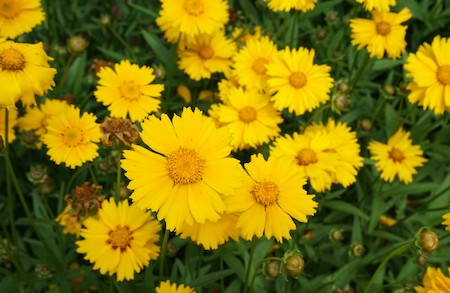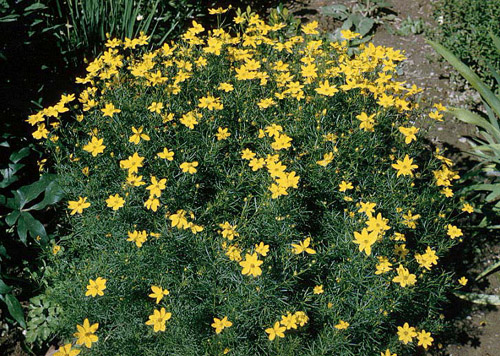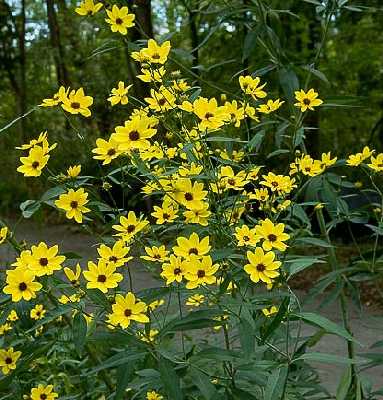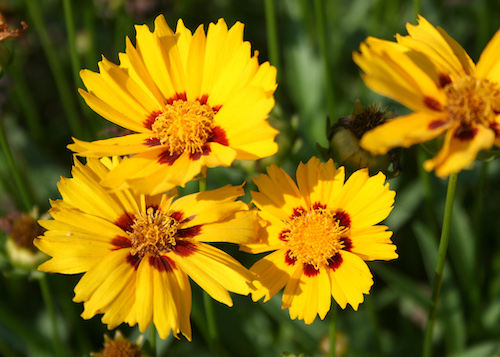Cheers for Cheerful Coreopsis
by Kathleen Curthoys, Fairfax Master Gardener

Coreopsis lanceolata
The sunny yellow coreopsis welcomes songbirds and pollinators into the garden, where the native perennial provides them with nectar and seeds during its long blooming season.
The plant family Asteraceae includes approximately 80 species of coreopsis and many cultivars. They are related to asters. Some are native to Virginia and grow in Zones 5 to 8 or 9. The common name of “tickseed” comes from the seeds’ resemblance to tiny bugs. The name coreopsis is derived from the Greek “koris,” meaning a type of bug, and “opsis,” related to appearance or resemblance.
The cheerful flowering plant is one of the perennials recommended for planting in full sun and dry to medium moisture soil that can be rocky, sandy or poor and well-drained. It tolerates heat and drought. Natives such as coreopsis need less water and maintenance than flowering annuals, and in some cases commercial property managers are replacing annuals in landscape beds with natives such as coreopsis.
In garden beds, borders or open spaces, coreopsis can readily naturalize by spreading its rhizomes in the soil and also dispersing seeds. The plant can be an aggressive self-seeder, which can be controlled to some extent by deadheading spent blooms.
Growth habits vary, from dense mounds of blooms on shorter clumps of foliage, to tall stems topped with a scattering of flowers. Plants can be 1 to 4 feet (30 to 120 cm) tall, depending on the species. Flower forms can resemble daises. Blooms are most commonly bright yellow and some cultivars may have maroon or brown centers and/or striped patterns. A few varieties have pink or red flowers. Late in the season, flowering may be sparse, and shearing can prompt new growth.
Many creatures are attracted by coreopsis, such as bees, hover flies, wasps, butterflies, birds and small mammals. Birds known to visit coreopsis include grosbeaks, cardinals, finches, sparrows and towhees.
You can bring the sunny coreopsis inside for cut-flower bouquets, where it may last up two weeks.Some varieties are native to Virginia. For example, a native plant garden at Richmond’s Lewis Ginter Botanical Garden has showcased Coreopsis verticillata ‘Broad Street’ Cruizin, Coreopsis grandiflora ‘Domino,’ Coreopsis verticillata ‘Zagreb’ and Coreopsis auriculata ‘Nana.’
Here are details about a few varieties native to northern Virginia:

Coreopsis verticillata
Coreopsis verticillata
The common name is threadleaf coreopsis or whorled coreopsis. Common to the eastern U.S., it grows in Zones 3 to 9. Clumps grow 2 ½ to 3 feet high (75 to 100 cm), and they spread 1½ to 2 feet. (45 to 60 cm) Yellow flowers with gold centers are 1 to 2 inches (2 to 5 cm) across (and bloom from June to October. Leaves are palmately shaped with a fine texture. Sheer plants in mid to late summer to encourage rebloom in fall and cut back any sprawling, unwanted foliage.
‘Zagreb’ is a popular compact cultivar with blooms relatively uniform in coverage and height. It is shorter than some types of verticillata, at about 20 inches (50 cm) tall. The foliage is attractive even before the plant is in bloom. Its dense growth makes it susceptible to powdery mildew developing but that may not be very noticeable on the fine leaves.
‘Golden Dream’ typically grows in a dense clump to a foot tall and a foot wide (30 cm), blooming late spring to late summer and potentially into fall. Blooms have yellow-orange centers and darker stripes on petals. While Golden Dream spreads with rhizomes, it doesn’t reseed.

Coreopsis tripteris
Coreopsis tripteris
Also known as tall tickseed, this variety grows 3 to 8 or more feet tall (so it’s suited to the back of the herbaceous border or naturalizing in wildflower gardens or meadows. Light yellow blooms with dark brown centers appear June or July through September. Flowers bloom atop slender, erect stems. The narrow tripartite leaves may be scented like anise.
Plant in full sun. If soil is dry, the plants may be shorter and less dense than when planted in consistently medium moisture soil. If the soil is too moist and poorly drained, crown rot may develop.
This plant readily self-seeds and may naturalize into large colonies. Tripteris growing in borders should be divided after two to three years to keep it robust. The tall plants may sprawl and need support, especially if exposed to wind.

Coreopsis grandiflora
Coreopsis grandiflora
Flowers with golden yellow centers and deep notches at the petals’ tips grow up to 3 inches (7 cm) across between late spring and late summer. The clump-forming plants remain shorter at 1 to 3 feet tall and wide (.03 to 1 m).
Large-flower tickseed can spread by rhizomes and reseed but may not be reliably perennial. The clumps can be divided every two to three years in early spring to increase the number of plants. They are suited to garden borders, rock gardens and along pathways. The blooming season is long and can go further when spent flowers are deadheaded.
Coreopsis is generally resistant to deer, but slugs and snails may show up. Coreopsis tends not to have significant problems with insect or disease. The plant may develop botrytis, which is a gray mold caused by fungus, as well as powdery mildew, root or stem rot, rust and fungal spots. Chances of powdery mildew are diminished when plants have good air circulation and aren’t too crowded. Crown rot may happen if soil is not well-drained.
Considered easy to grow, enthusiastic and resilient, coreopsis has many ways to brighten a gardener’s day.
-
References
- For the Birds, Butterflies & Hummingbirds: Creating Inviting Habitats, Virginia Cooperative Extension
- Coreopsis, Plant Finder, Missouri Botanical Garden
- Native Plants for Wildlife Habitat and Conservation Landscaping, Chesapeake Bay Watershed, U.S. Fish and Wildlife Service
- Native Plants of Northern Virginia, Plant Northern Virginia (NOVA) Natives